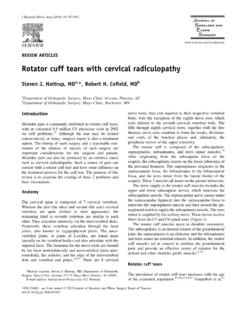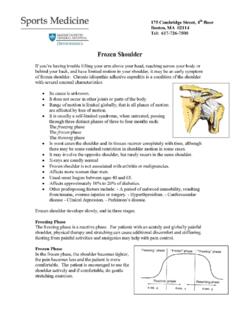Transcription of Long-term activity restrictions after shoulder ...
1 Long-term activity restrictions after shoulderarthroplasty: an international survey of experiencedshoulder surgeonsRobert A. Magnussen, MDa,*, William J. Mallon, MDb, W. Jaap Willems, MD, PhDc,Claude T. Moorman III, MDaaDuke Sports Medicine, Duke University Medical Center, Durham, NC, USAbTriangle Orthopaedic Associates, PA, Durham, NC, USAcDepartment of Orthopedic Surgery and Traumatology, Onze Lieve Vrouwe Gasthuis Hospital, Amsterdam, The NetherlandsHypothesis: shoulder arthroplasty is being performed with increasing frequency, and patients athletic partici-pation after shoulder arthroplasty is on the rise. However,little data exist regarding appropriate Long-term activityrestrictions. We hypothesize that European and North american surgeonsboth recommend increasing long-termactivity restrictions , moving from hemiarthroplasty to total shoulder arthroplasty (TSA) to reverse total shoulderarthroplasty (RTSA), and that both groups impose similar restrictions on their and methods:An online survey was sent to members of the american shoulder and ElbowSurgeons (ASES) and the European Society for Surgery of the shoulder and Elbow (SECEC).
2 Participantsreceived a list of 37 activities and classified their postoperative recommendations for each activity as allowed,allowed with experience, not allowed, or :The participation rate was 18%, including 47 North american surgeons and 52 European patients were allowed toparticipate in nonimpact activities, including jogging/running, walking, stationarybicycling, and ballroom dancing. Sports requiring light upper extremity involvement, including low-impactaerobics, golf, swimming, and table tennis, were allowed after hemiarthroplasty and TSA, and were allowedwith experience after RTSA. Sports with fall potential, including downhillskiing, tennis, basketball, and soccer,were allowed with experience after hemiarthroplasty and TSA, and undecided or not allowed after sports, such as weightlifting, waterskiing, and volleyball, were undecided after hemiarthroplastyand TSA and were not allowed after RTSA.
3 European surgeons were more conservative than Americansurgeons in their recommendations after hemiarthroplasty and TSA, but good agreement between the 2 groupswas noted regarding restrictions after : restrictions should be based on the type of arthroplasty performed and patients of evidence:Level V, Survey Research, Expert Opinion. 2011 Journal of shoulder and Elbow Surgery Board of :Total shoulder arthroplasty; reverse total shoulder arthroplasty; shoulder hemiarthroplasty; activityrestrictions; surveyShoulder arthroplasty is being performed with increasingfrequency for a variety of indications throughout the studies have been published detailing*Reprint requests: Robert A. Magnussen, MD, DUMC Box 3615,Durham, NC Magnussen).J shoulder Elbow Surg (2011) 20, $ - see front matter 2011 Journal of shoulder and Elbow Surgery Board of protocols based on patient factors, surgicalindications, and implant selection.
4 Several recent studieshave shown that most patients maintain their athleticparticipation after hip or knee arthroplasty,2,10but much lessis known about activity level after shoulder arthroplasty. Onerecent study of patients undergoing shoulder arthroplastydemonstrated increased athletic participation after shoulderarthroplasty and noted that 64% of patients cited a desire toreturn to sports as one of the reasons they underwent studies have shown relatively high levelsof return to golf after shoulder ,5A relative paucity of data exist regarding appropriate Long-term activity restrictions after shoulder arthroplasty. Signifi-cantly more has been published on activity restriction after hipand knee arthroplasty, with authors focusing primarily on returnto golf and tennis. Surveys of the Hip Society and the AmericanAssociation of Hip and Knee surgeons have documentedincreasing physician acceptance of higher activity levels afterjoint ,6 Generally, high-impact activities should beavoided due to concerns over loosening, but low-impact sportsare well accepted by our knowledge only 1 previous survey of experts in thefield has been performed of Long-term restrictions after published recommendations are based onindividual surgeon ,9We hypothesize that surgeonsrecommend increasing Long-term activity restrictions , movingfrom hemiarthroplasty to total shoulder arthroplasty (TSA) toreverse totalshoulder arthroplasty (RTSA).
5 We do not anticipatesignificant variations in these recommendations based onwhether surgeons practice in North America or and methodsApproval for this study was obtained from Duke University MedicalCenter Institutional Review Board (Approval No. Pro00019667).Survey populationWith the support of the american shoulder and Elbow surgeons (ASES) and the European Society for Surgery of the shoulder andElbow (SECEC), an online survey (Survey Monkey, , Portland, OR) was designed to assesssurgeon preferences on Long-term activity restrictions aftershoulder arthroplasty. A link to the survey was sent by e-mail tothe 315 members of the ASES and the 322 members of theSECEC with an e-mail address on file as of January 1, detailsThe survey collected each participant s practice location and thenumber of years each had been in practice. Participants wereasked if they performed shoulder hemiarthroplasty, TSA, or RTSAand were questioned further about only the procedures that theyperformed.
6 For each procedure, surgeons were asked how manythey perform annually and were asked to define the number ofmonths after surgery at which they would release the patient tomaximum activity level. Participants were presented with a list of37 activities and asked to classify their recommendations for eachactivity into 1 of 4 categories: (1) allowed, (2) allowed withexperience, (3) not allowed, or (4) undecided. These classifica-tions are similar to those used by previous authors and werechosen to facilitate comparison with earlier ,4 Statistical analysisAll survey responses were collected and tabulated. Statisticalanalysis proceeded as described by Klein et the numberof survey respondents who performed each procedure (hemi-arthroplasty, n 98; TSA, n 94; RTSA, n 81), a poweranalysis for a 1-sample proportion test determined that 67% ofrespondents for hemiarthroplasty, 67% of respondents for TSA, or69% of respondents for RTSA would have to select any 1 of the4 categories to achieve statistical significance for that 1 Distribution of surgeons participating in the surveybased on number of years in practice.
7 No significant differencesare noted between North american and European 2 The time after which surgeons allow patients to returnto their maximum permitted activity level after hemiarthroplasty,total shoulder arthroplasty, or reverse total shoulder Magnussen et each activity surveyed, the percentage of respondentsselecting each category was compared with the required percentagefor statistical significance. Any category that exceeded the requiredpercentage was determined to be the overall recommendation forthat activity . For activities in which no category received therequisite percentage of respondents, further analysis was preformedwithc2tests. Responses in the allowed and allowed withexperience categories were combined and compared with the sumof responses in the not allowed and undecided categories. Ifthe combined allowed and allowed with experience responsessignificantly (P<.)
8 05) exceeded the combined not allowed and undecided responses, the overall recommendation was allowedwith experience. Similarly, if the combined not allowed and undecided responses significantly (P<.05) exceeded thecombined allowed and allowed with experience responses, theoverall recommendation was not allowed. If the differencebetween the groups was not statistically significant, undecided was the overall the effect of practice location was compared withactivity restriction, allowed and allowed with experience responses were pooled and compared with not allowed responses for each activity using IActivity recommendations after hemiarthroplastyActivityAllowed, %Allowed with experience, %Not allowed, %Undecided, %NorthAmericaEurope All NorthAmericaEuropeAllNorthAmericaEurope All NorthAmericaEurope AllRacquetball581836 295141929204 23 Jogging/running989094285021000 american football 16811 90475717302211 Baseball/softball61183727313154124 7108 AerobicsHigh-impact66254325373273722 201 Low-impact95788652013000021 Martial arts401225 3614252261432127 TennisSingles60334636413942515 000 Doubles76375524413302010 021 Basketball69164022373174528 222 Stairclimber98617921690189063 Hiking96637842516063063 SkiingDownhill513442 42564941072 01 Cross-country8245611839310168 000 Snowboarding402532422735164331 243 Weightlifting451227 41825147445063 Ice skating7339542541350189 222 Rollerblading71395322292872415 084 Bowling82556813221741811 063 Road cycling878284131414042 000 Rowing80375616372822011 265 Walking989697222021000
9 Ballroom dancing9388917108000021 Pilates826673131816042 4128 Golf91647793422021000 Swimming91848791411021000 Lacrosse411627 23162032313253721 Elliptical trainer9838662161008403820 Stationary bicycle959495544021000 Fencing7326472052390126 7108 Football (soccer)602641243430133425 264 Table tennis8961731125200126 021 Waterskiing421024 3624302057402106 Volleyball561433 36243095936042 Team handball5382929 16 22 965399109 Track and fieldSprinting64485524292871712 465 Throwing441428 312429185637766 NOTE. The most frequent recommendation for each activity is listed in bold restrictions after shoulder arthroplasty283 The number of procedures performed annually and time tomaximum activity level were compared between the North Americanand European groups using a Wilcoxon ranked sum test. The rela-tionship between the number of procedures performed annually and thetime to maximum activity level was evaluated using linear rateThe 637 e-mailed invitations to society members yielded101 completed online surveys.
10 The participation rates weresimilar between the groups, reaching (58 of 315)among ASES members and (56 of 322) amongSECEC members. Thirteen of those who participated weremembers of both societies. The overall participation ratewas about 18%, but cannot be precisely determined becausewe do not know how many of the surgeons invited toparticipate were members of both respondents included 47 surgeons practicing in NorthAmerica, 52 surgeons practicing in Europe, and 1 surgeonTable IIActivity recommendations after total shoulder arthroplastyActivityAllowed, %Allowed with experience, %Not allowed, %Undecided, %NorthAmericaEurope All NorthAmericaEuropeAllNorthAmericaEurope All NorthAmericaEurope AllRacquetball371222374139224535 523 Jogging/running908286101211042 021 american football 1025 745838685084 Baseball/softball361424 332730315343063 AerobicsHigh-impact531633 193327235138502 Low-impact93677872919021021 Martial arts17611 3415244969590105 TennisSingles402933 384342192924 201 Doubles64334833433822414 000 Basketball38822403135176141502 Stairclimber955977518120169063 Hiking98607722515084063 SkiingDownhill443136495351716122 01 Cross-country74375326413502011 021 Snowboarding221618462436325745021 Weightlifting24614481429298057000 Ice skating562237 395348524150 00 Rollerblading483138383537123323 201 Bowling674757243328101814 021 Road cycling767375192321243 201 Rowing65294521393192417 587




